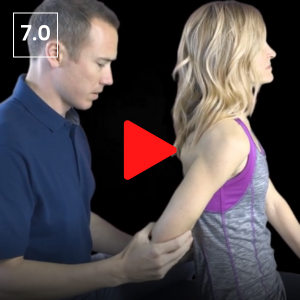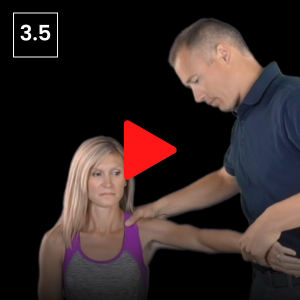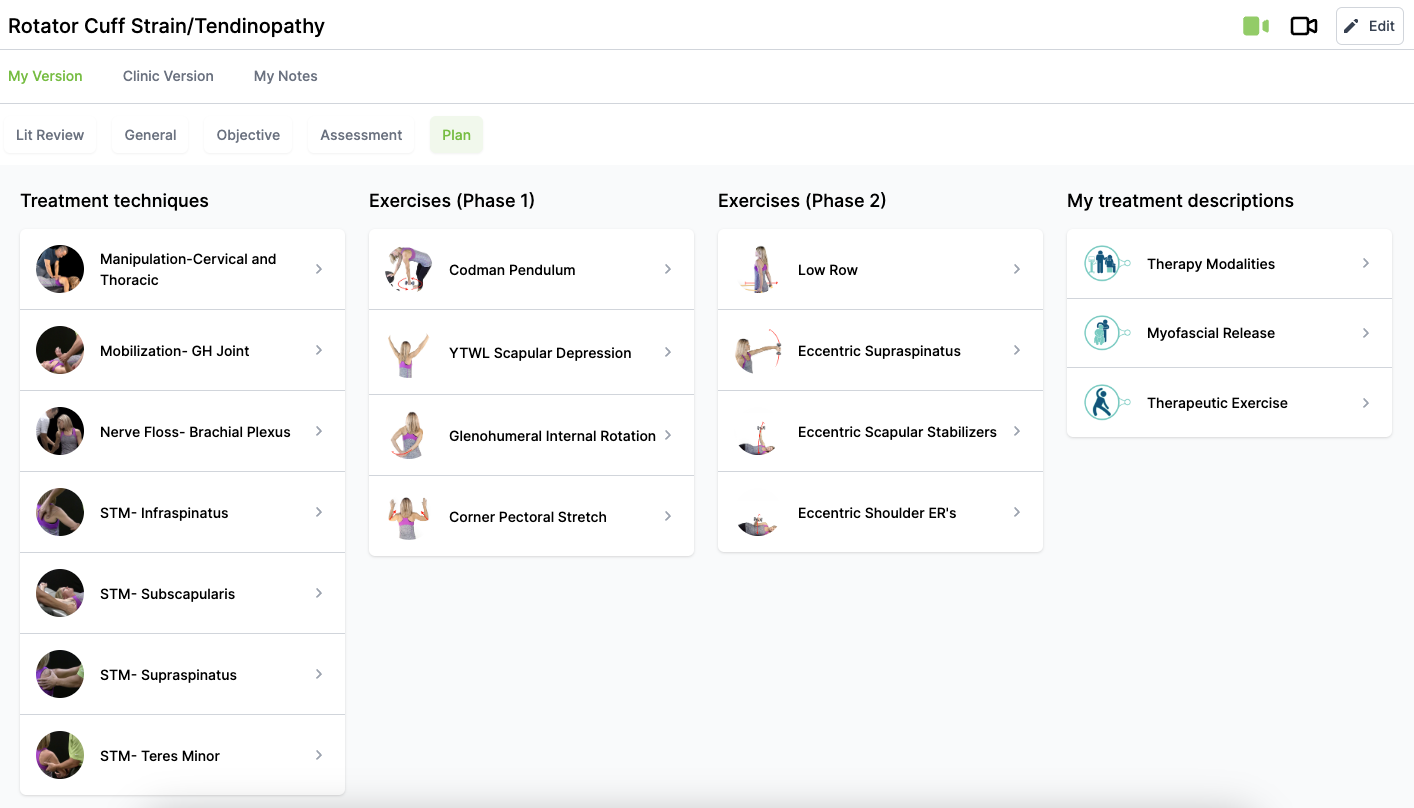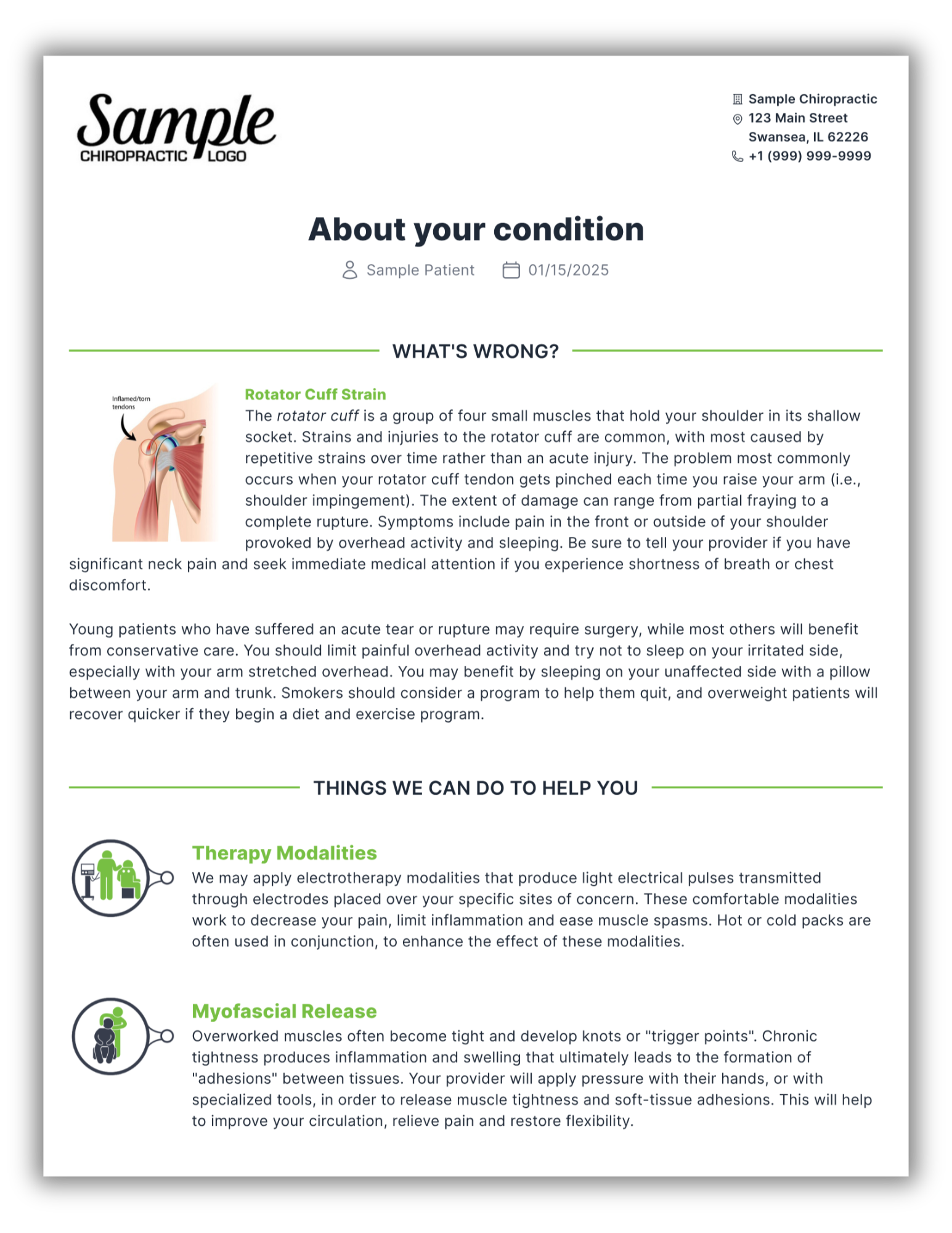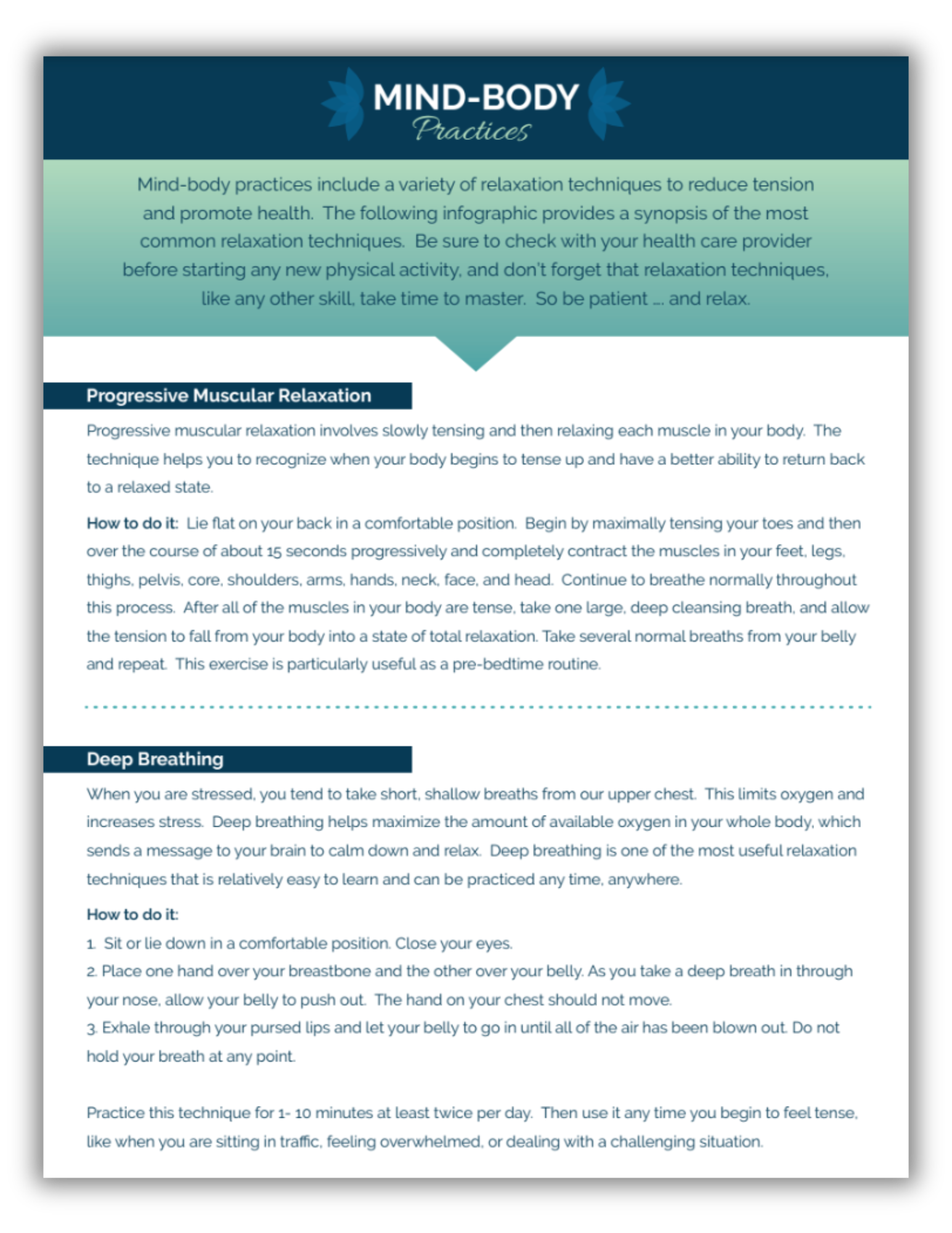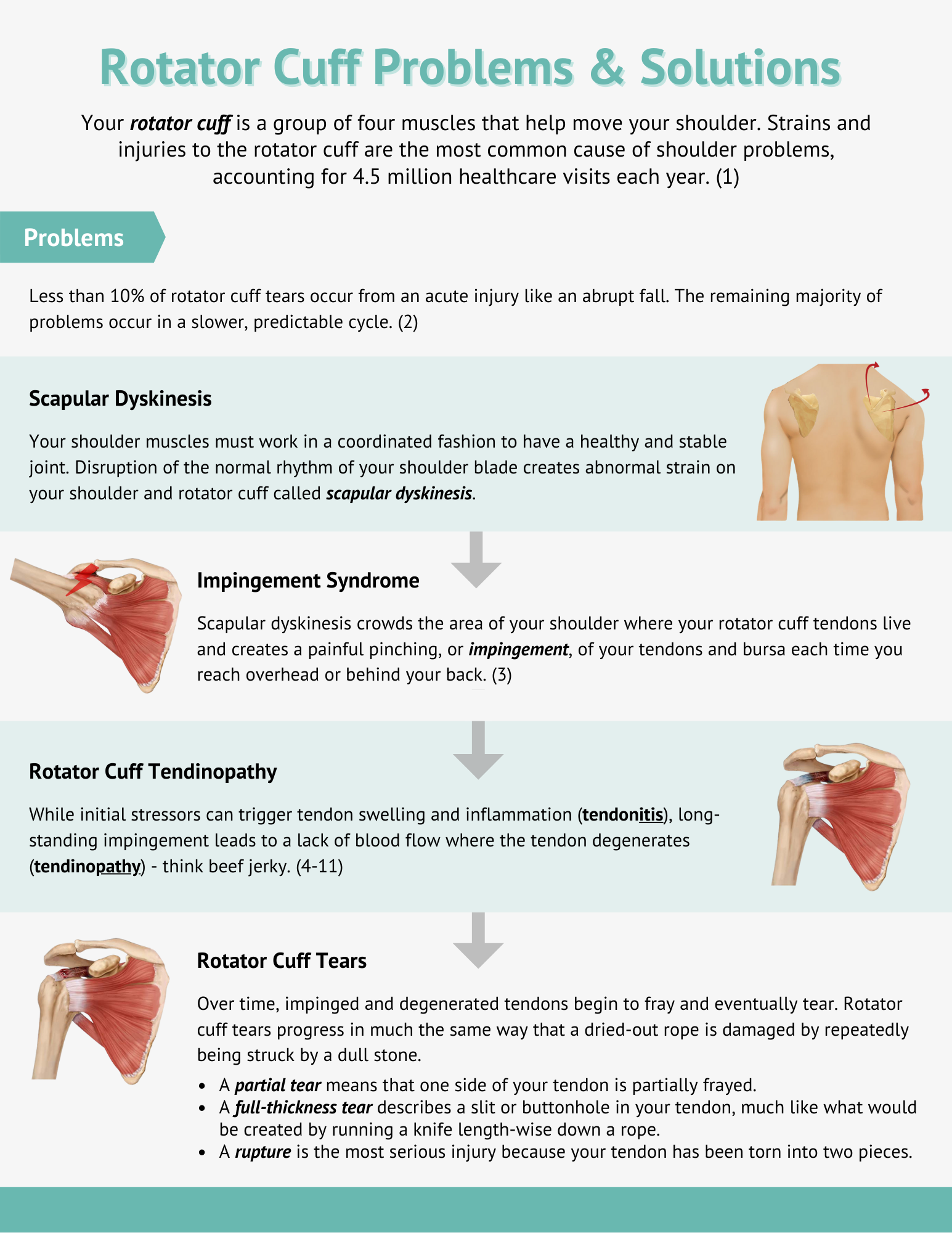7 New Research Findings Every DC Needs to Know About Rotator Cuff Injuries
Over 1,500 new studies on rotator cuff tendinopathies have been published in the past year alone, including 135 systematic reviews. While you likely didn’t have time to read them all, your ChiroUp team did the work for you!
We’ve distilled the most important research findings from the past year, ensuring you have the most up-to-date knowledge to diagnose and treat rotator cuff issues. From risk factors to resolution, these insights will help you claim your rightful position as the go-to provider for rotator cuff tendinopathy.
1. Rotator Cuff Risk Factors
Research has uncovered several key risk factors for rotator cuff injuries, most of which are tied to conditions that hinder the tendon’s vascular supply, setting the stage for degeneration and tears.
Rotator cuff tendinopathy risk factors:
Age: Rotator cuff degeneration is closely tied to aging, with tears becoming increasingly prevalent and severe in older populations. This progression is attributed to muscle atrophy, fatty infiltration, and reduced vascular supply over time (1).
Obesity: Excess body weight is strongly linked to both the occurrence and severity of RCD. Individuals with obesity are 1.4 times more likely to have a rotator cuff tear compared to those without, with every 5-unit increase in BMI raising the odds by 35%. (2) Furthermore, obesity leads to worse post-surgical outcomes, including greater pain, diminished shoulder function, and higher rates of complications and readmissions. (3,4)
Smoking, Hypertension, and Other Microcirculation Factors: Peripheral microcirculation issues, including those caused by smoking, hypertension, or hypercholesterolemia, play a significant role in rotator cuff pathology. Studies show that 63% of patients with rotator cuff tears had either smoked or had at least one condition affecting microcirculation. And tear severity escalates with the presence of these risk factors. (5)
Steroid injections: Designed to decrease the body’s natural inflammatory response, corticosteroid injections can negatively impact outcomes, even increasing the risk of revision rotator cuff surgery by 47%. (6)
Occupational Strain: Certain occupational activities significantly increase the risk of rotator cuff injuries, with overhead tasks and repetitive movements more than doubling the likelihood of injury. (7)
2. Top Rotator Cuff Injury Test
The accuracy of diagnostic tests for rotator cuff injuries varies, but a BMC Musculoskeletal Disorders systematic review quantified the reliability of several common assessments. Among these, the External Rotation Lag Sign (performed at 90 degrees of shoulder abduction) proved the most reliable rotator cuff injury test. (8) Here are the rotator cuff tests with the highest diagnostic odds ratio (DOR):
Don't forget the DIME Test for Rotator Cuff Tears
Notably, the authors of the BMC Musculoskeletal Disorders did not evaluate the newer DIME test, which boasts a significantly higher diagnostic odds ratio than the other tests discussed. Learn more about the DIME test for rotator cuff injury in this prior blog.
Research In Action: Check out this shoulder exam tutorial for a complete step-by-step guide.
If you want an even deeper dive, navigate to the home of the top chiropractic webinar and watch our advanced tutorial on When it’s Not the Rotator Cuff, detailing the assessment and treatment of four commonly overlooked shoulder problems.
3. Manual Therapy Enhances Outcomes
Multiple studies in prior years underscored the effectiveness of spinal manipulation and manual therapy as a cornerstone treatment for rotator cuff tendinopathy. (9-11) This year's research again confirms that a multimodal approach—including exercise, manual therapy, and other targeted treatments—delivers the best outcomes for pain relief and functional improvement.
“Combining [manual therapy] with exercise had significant advantages over exercise alone, as combined therapy contributed to both pain reduction and functional enhancement” (12)
Techniques like Mobilization with Movement (MWM) are particularly effective in improving range of motion and reducing pain (13).
Our review of 2024 Top Chiropractic Research highlighted several new studies showing nerve mobilization improves outcomes for various extremity complaints, ranging from carpal tunnel syndrome to lateral epicondylopathy. While our review did not find any 2024 papers discussing the effect of neurodynamic techniques for rotator cuff pathology, we would be remiss not to mention it at least. Check out this prior tutorial video for a refresher.
Research In Action: Want video tutorials for all of the top rotator cuff treatments, rotator cuff tests, and rotator cuff exercises? Subscribers can review the entire best practice protocol for rotator cuff tendinopathy (and more than 175 other MSK diagnoses) from their ChiroUp condition reference database.
4. Rotator Cuff Exercises Are Essential, but the Best Type Remains Debated
“Uncertainty underpins much of the theory and practice of delivering exercise therapy for individuals with rotator cuff-related shoulder pain. Nonetheless, we contend that providing exercise therapy should remain a principal treatment option.” (14).
Prior research underscores the importance of progressive muscular loading and eccentric exercises for improving strength and recovery. Motor control programs have shown merit over nonspecific exercise regimens. (15) Patient-specific and gradual exercise progression is key for optimal outcomes.
Research In Action: While the perfect formula for rotator cuff tear exercises remains debatable, research has established key components for success. Subscribers can confidently prescribe these evidence-based programs and easily customize protocols to include their top exercises for rotator cuff, then deliver that information in four clicks.
5. Shockwave Shows Promise
Shockwave therapy (ESWT) has emerged as a viable option for managing rotator cuff tendinopathy, with growing evidence supporting its use. It has been shown to reduce pain and improve function with low adverse event rates. (16-18)
“This study suggests that ESWT can be a highly effective therapy option for relieving pain in people with tendinopathy. Additionally, in individuals with rotator cuff tendinopathy, the SMD for pain reduction was 2.37 units.” (17)
6. Mental Health Affects Outcomes
Psychological factors are associated with the occurrence of shoulder disorders, including rotator cuff issues. (19) And psychological health significantly influences recovery from rotator cuff injuries. Patients with psychological impairments report higher pain levels and slower healing rates (20).
Research In Action: Subscribers can explore our "Rethinking Chronic Pain" and "Mind-Body Best Practices" infographics in the Forms Library for actionable insights on managing pain through a positive mental outlook.
7. Emerging Regenerative Therapies
While most chiropractors primarily focus on non-injectable care, understanding regenerative therapies can help provide patients with informed recommendations or guidance for surgical recovery. Recent research highlights the potential of these treatments to enhance tendon healing and reduce failure rates following rotator cuff repair.
Prolotherapy: This injection-based treatment stimulates the body’s natural healing response by introducing a mild irritant, like dextrose, to strengthen ligaments and tendons, showing positive results in managing tendinopathy (21,22)
Platelet-Rich Plasma (PRP): PRP, derived from the patient’s own blood, is rich in platelets and growth factors that regenerate tendon-to-bone microarchitecture. Studies indicate it reduces the likelihood of retears and improves outcomes when used intraoperatively (23-27)
Stem Cell Therapy: Adipose-derived and mesenchymal stem cells show promise in reducing muscle fatty degeneration in massive tears. (28)
Conclusion
Perhaps Bedi et al. provided the year’s best summary concerning rotator cuff pathology:
“Rotator cuff tears are the most common upper extremity condition seen by primary care…with a spectrum ranging from tendinopathy to full-thickness tears. Some tears are traumatic, but most rotator cuff problems are degenerative. Not all tears are symptomatic and not all progress, and many patients in whom tears become more extensive do not experience symptom worsening. Rotator cuff tears begin as degenerative changes within the tendon, with matrix disorganization and inflammatory changes. Subsequently, tears progress to partial-thickness and then full-thickness tears. Treatment depends primarily on symptoms, with non-operative management sufficient for most patients with rotator cuff problems.” (29)
There you have it! The latest research continues to validate the principles and practices we use daily in our offices. By staying aligned with current evidence and leveraging these insights, we solidify our role as top-tier providers for managing rotator cuff pathologies. By embracing cutting-edge knowledge and delivering exceptional care, we will become the undeniable best choice for patients and payors.
Research In Action: Now share the news with your patients and social media followers via this updated ChiroUp rotator cuff infographic and explainer video.
ChiroUp is the leading online platform for evidence-based chiropractic. Together, we are elevating and uniting the chiropractic profession.
-
1. Wang N, Wang H, Shen L, Liu X, Ma Y, Wang C. Aging‐Related Rotator Cuff Tears: Molecular Mechanisms and Implications for Clinical Management. Advanced Biology. 2024 Apr;8(4):2300331. Link
2. Herzberg SD, Garriga GA, Jain NB, Giri A. Elevated Body Mass Index Is Associated with Rotator Cuff Disease: A Systematic Review and Meta-analysis. Arthroscopy, Sports Medicine, and Rehabilitation. 2024 May 31:100953. Link
3. Ma X, Shen J, Wan J. Impact of obesity on outcomes of rotator cuff repair: A systematic review and meta-analysis. Plos one. 2024 Mar 13;19(3):e0299125. Link
4. Sandler AB, Green CK, Scanaliato JP, Fares AB, Dunn JC, Parnes N. The Influence of Obesity on Outcomes Following Arthroscopic Rotator Cuff Repair: A Systematic Review and Meta-Analysis of 118,331 Patients Internationally. JBJS Open Access. 2024 Apr 1;9(2):e23. Link
5. Gumina S, Orsina L, Song HS, Kim H, Bartocci D, Candela V. Rotator Cuff Tear Size: Could It Be Influenced by the Presence of One or More Diseases Capable of Altering the Peripheral Microcirculation?. Journal of Clinical Medicine. 2024 Oct 7;13(19):5965. Link
6. Darbandi AD, Cohn M, Credille K, Hevesi M, Dandu N, Wang Z, Garrigues GE, Verma N, Yanke A. A Systematic Review and Meta-analysis of Risk Factors for the Increased Incidence of Revision Surgery After Arthroscopic Rotator Cuff Repair. The American Journal of Sports Medicine. 2024 Apr;52(5):1374-83. Link
7. Diener GL, Spahn G, Hofmann GO. Berufliche Belastung als möglicher Risikofaktor für einen Rotatorenmanschettenschaden-Systematisches Review und Meta-Analyse. Zeitschrift für Orthopädie und Unfallchirurgie. 2022 Dec 6. Link
8. Zhao Q, Palani P, Kassab NS, Terzic M, Olejnik M, Wang S, Tomassini-Lopez Y, Dean C, Shellenberger RA. Evidence-based approach to the shoulder examination for subacromial bursitis and rotator cuff tears: a systematic review and meta-analysis. BMC Musculoskeletal Disorders. 2024 Dec 19;25:1028. Link
9. Strunce JB, Walker MJ, Boyles RE, Young BA. The immediate effects of thoracic spine and rib manipulation on subjects with primary complaints of shoulder pain. Journal of Manual & Manipulative Therapy. 2009 Dec 1;17(4):230-6. Link
10. Walser RF, Meserve BB, Boucher TR. The effectiveness of thoracic spine manipulation for the management of musculoskeletal conditions: a systematic review and meta-analysis of randomized clinical trials. Journal of Manual & Manipulative Therapy. 2009 Dec 1;17(4):237-46. Link
11. Southerst D, Yu H, Randhawa K, Côté P, D’Angelo K, Shearer HM, Wong JJ, Sutton D, Varatharajan S, Goldgrub R, Dion S. The effectiveness of manual therapy for the management of musculoskeletal disorders of the upper and lower extremities: a systematic review by the Ontario Protocol for Traffic Injury Management (OPTIMa) Collaboration. Chiropractic & manual therapies. 2015 Dec;23(1):30. Link
12. Liu S, Chen L, Shi Q, Fang Y, Da W, Xue C, Li X. Efficacy of manual therapy on shoulder pain and function in patients with rotator cuff injury: A systematic review and meta‑analysis. Biomedical Reports. 2024 Jun 1;20(6):1-2. Link
13. Çelik D, Van Der Veer P, Tiryaki P. The Clinical Significance of Mulligan’s Mobilization with Movement in Shoulder Pathologies: A Systematic Review and Meta-Analysis. Journal of Integrative and Complementary Medicine. 2024 Aug 27. Link
14. Powell JK, Lewis J, Schram B, Hing W. Is exercise therapy the right treatment for rotator cuff‐related shoulder pain? Uncertainties, theory, and practice. Musculoskeletal Care. 2024 Jun;22(2):e1879. Link
15. Lafrance S, Charron M, Dubé MO, Desmeules F, Roy JS, Juul-Kristensen B, Kennedy L, McCreesh K. The efficacy of exercise therapy for rotator cuff related shoulder pain according to the FITT principle: a systematic review with meta-analyses. Journal of Orthopaedic & Sports Physical Therapy. 2024 Aug;54(8):1-26. Link
16. Xue X, Song Q, Yang X, Kuati A, Fu H, Cui G. Effect of extracorporeal shockwave therapy for rotator cuff tendinopathy: a systematic review and meta-analysis. BMC Musculoskeletal Disorders. 2024 Dec;25(1):1-20. Link
17. Majidi L, Khateri S, Nikbakht N, Moradi Y, Nikoo MR. The effect of extracorporeal shock-wave therapy on pain in patients with various tendinopathies: a systematic review and meta-analysis of randomized control trials. BMC Sports Science, Medicine and Rehabilitation. 2024 Apr 24;16(1):93. Link
18. Xiong Y, Wen T, Jin S, Lin L, Shao Q, Peng Y, Zheng Q, Li W. Efficacy and safety of extracorporeal shock wave therapy for upper limb tendonitis: a systematic review and meta-analysis of randomized controlled trials. Frontiers in Medicine. 2024 Jul 30;11:1394268. Link
19. Versloot AH, Jackson JA, van Rijn RM, Elbers RG, Søgaard K, Macri EM, Koes B, Burdorf A, Chiarotto A, Gerger H. Physical and psychosocial work-related exposures and the occurrence of disorders of the shoulder: A systematic review update. Applied Ergonomics. 2024 Jul 1;118:104277. Link
20. Feltri P, Monteleone AS, Audige L, Marbach F, Filardo G, Candrian C. Patients with rotator cuff tears present a psychological impairment, not only a functional deficit: a systematic review. International Orthopaedics. 2024 Jan;48(1):169-81. Link
21. Han L, Hu N, Wang C, Ye Z, Wang T, Lan F. Platelet-rich plasma-derived exosomes promote rotator cuff tendon-bone healing. Injury. 2024 Feb 1;55(2):111212. Link
22. Desouza C, Shetty V. Effectiveness of Platelet-rich Plasma in Partial-thickness Rotator Cuff Tears: a meta-analysis. Journal of ISAKOS. 2024 Apr 18. Link
23. Pitsilos C, Karachrysafi S, Fragou A, Gigis I, Papadopoulos P, Chalidis B. The Biological Effect of Platelet-Rich Plasma on Rotator Cuff Tears: A Prospective Randomized In Vivo Study. International Journal of Molecular Sciences. 2024 Jul 21;25(14):7957. Link
24. Sánchez-Losilla C, Ferré-Aniorte A, Álvarez-Díaz P, Barastegui-Fernández D, Cugat R, Alentorn-Geli E. Eficacia del plasma rico en plaquetas en la reparación del manguito rotador: revisión sistemática y metaanálisis. Revista Española de Cirugía Ortopédica y Traumatología. 2024 May 1;68(3):296-305. Link
25. Shen Z, Ye X, He Y, Shen G, Xu K, Zhang B, Wu L. Arthroscopic rotator cuff repair combined with platelet-rich plasma products can reduce the rate of retearing and improve clinical outcomes: A meta-analysis of randomized controlled trials. Medicine. 2024 May 3;103(18):e38069. Link
26. Capotosto S, Nazemi AK, Komatsu DE, Penna J. Prolotherapy in the Treatment of Sports-Related Tendinopathies: A Systematic Review of Randomized Controlled Trials. Orthopaedic Journal of Sports Medicine. 2024 Nov;12(11):23259671241275087. Link
27. Nunes B, Martins R, Linhares D, Azevedo L, Canadas R, Gutierres M. Effect of Platelet-Rich Plasma Dosing for Healing after Arthroscopic Cuff Repair Compared to Surgery Alone: A Systematic Review and Meta-Analysis. Medicine and Science in Sports and Exercise. 2024 Mar 14. Link
28. Stamiris D, Valasidis A, Cheva A, Papavasiliou K, Stamiris S, Potoupnis M, Poultsides L, Tsiridis E, Sarris I. Interventions used to mitigate muscle fatty degeneration following the repair of massive rotator cuff tears. A systematic review of animal studies. Orthopaedics & Traumatology: Surgery & Research. 2024 Feb 1;110(1):103723. Link
29. Bedi A, Bishop J, Keener J, Lansdown DA, Levy O, MacDonald P, Maffulli N, Oh JH, Sabesan VJ, Sanchez-Sotelo J, Williams III RJ. Rotator cuff tears. Nature Reviews Disease Primers. 2024 Feb 8;10(1):8. Link


